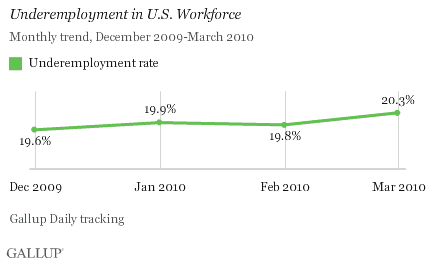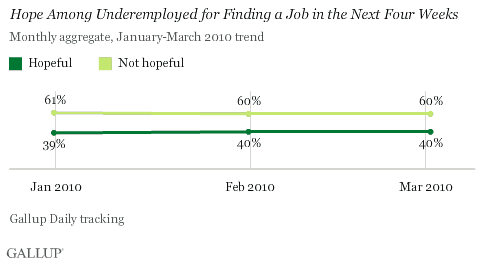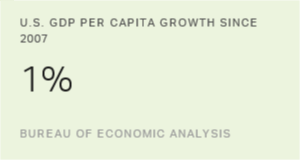WASHINGTON, D.C. -- Gallup Daily tracking finds that 20.3% of the U.S. workforce was underemployed in March -- a slight uptick from the relatively flat January and February numbers.

"The underemployed in March became neither more nor less hopeful about finding work soon."
These results are based on March interviews with more than 20,000 adults in the U.S. workforce, aged 18 and older. Gallup classifies respondents as underemployed if they are unemployed or working part-time but wanting full-time work. Gallup employment data are not seasonally adjusted.
A rise in the percentage of part-timers wanting to work full time (from 9.2% to 9.9%) is responsible for the March increase in underemployment. Unemployment saw a slight, but insignificant, decline in March.

Underemployed Americans Still Not Hopeful
Despite the Obama administration's March 16 announcement that unemployment would remain high or increase in coming months, the underemployed in March became neither more nor less hopeful about finding work soon. Six in 10 underemployed Americans are not hopeful they will find work or move from part-time to full-time work in the next four weeks. That translates to 12% of the workforce that is both underemployed and not hopeful they will find their desired amount of work. The lack of change suggests that underemployed Americans anticipated long-term difficulties in finding work well before the administration's formal announcement was made.

Bottom Line
As unemployed Americans find part-time, temporary, and seasonal work, the official unemployment rate could decline. However, this does not necessarily mean more Americans are working at their desired capacity. It will continue to be important to track underemployment -- to shed light on the true state of the U.S. workforce, and the millions of Americans who are searching for full-time employment.
Survey Methods
Results are based on telephone interviews with a random sample of 20,504 national adults, who are part of the workforce, aged 18 and older, conducted March 1-31, 2010. For results based on the total sample of national adults, one can say with 95% confidence that the maximum margin of sampling error is ±1 percentage points.
For results based on the sample of 4,164 adults who were underemployed in March, the maximum margin of sampling error is ±2 percentage points.
Interviews are conducted with respondents on landline telephones (for respondents with a landline telephone) and cellular phones (for respondents who are cell-phone only).
In addition to sampling error, question wording and practical difficulties in conducting surveys can introduce error or bias into the findings of public opinion polls.
